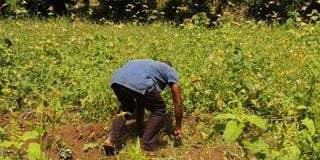Premium
Teams alert after desert locusts spotted in Meru

Desert locusts are pictured at Mitunguu along Kithino River in Meru County on February 14, 2020.
What you need to know:
- The county’s Agriculture executive, Carol Mutiga, said a large swarm entered the county on Sunday and settled in Tigania East the next day.
- Recently, the FAO said it is seeking to raise close to Sh4.5 billion to fight the current wave of the destructive pest in the Horn of Africa and Yemen.
Surveillance teams are monitoring a swarm of desert locusts covering up to 150 hectares that invaded Laciathuriu in Tigania East, Meru County, on Monday evening.
The county’s Agriculture executive, Carol Mutiga, said a large swarm entered the county on Sunday and settled in Tigania East the next day.
She said a control team is monitoring the situation ahead of control efforts.
“The surveillance teams spotted the swarm brooding in Laciathuriu on Monday evening. It comprises immature swarms which can cause damage. Aerial and ground control teams are ready to start spraying,” Ms Mutiga said.
According to the Food and Agriculture Organisation (FAO) of the United Nations, several immature swarms get into Kenya every day and spread west throughout the northern and central areas.
An update on January 18 states: “Swarms are now being seen in seven counties -- Wajir, Garissa, Marsabit, Samburu, Laikipia, Isiolo, Meru North -- compared to the last four weeks. A few are starting to mature. In the south east, hopper bands that could form swarms shortly are present near Taita-Taveta and the coast.”
The locusts reached the neighbouring Isiolo County on January 10, with a swarm covering more than 500ha spotted in Garbatulla.
Huge costs
Recently, the FAO said it is seeking to raise close to Sh4.5 billion to fight the current wave of the destructive pest in the Horn of Africa and Yemen.
This is in addition to more than Sh22 billion raised last year for desert locust control efforts in the region.
The FAO said 1,500 ground control and surveillance personnel have been trained, 110 vehicle-mounted sprayers deployed and 20 aircraft dispatched for use in aerial control and surveys.
"We have achieved much but the battle against this relentless pest is not yet over. We must not waver. Locusts keep growing day and night, exacerbating food insecurity for vulnerable families across the affected region," said FAO Director-General Qu Dongyu.
Early in January, the United Nations set aside Sh164 million from its Central Emergency Response Fund to fight the desert locust upsurge in Kenya.





